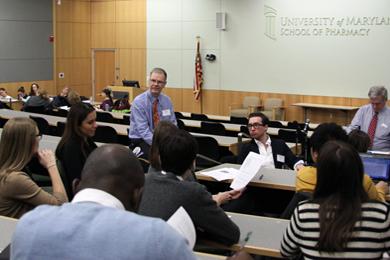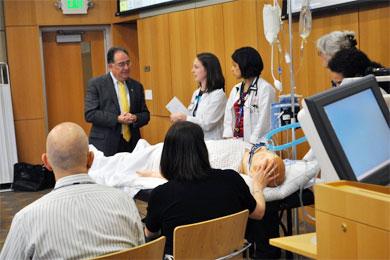SOP’s Congdon Named Co-Director of University’s Center for IPE
Newly established center will help students from all UMB professional schools learn and work together across disciplines.
By Malissa Carroll
December 13, 2013
Heather Congdon, PharmD, BCPS, CDE, associate professor in the Department of Pharmacy Practice and Science (PPS) at the University of Maryland School of Pharmacy and assistant dean for the School at the Universities at Shady Grove, has been named a co-director of the new Center for Interprofessional Education (IPE) at the University of Maryland, Baltimore (UMB). The Center, which officially launched on Nov. 20, is directed by Jane M. Kirschling, PhD, RN, FAAN, dean and professor of the School of Nursing, and monitors all of the IPE initiatives in which faculty, staff, and students at UMB are engaged.
“The University of Maryland School of Pharmacy has long been a proponent of interprofessional education and practice, a concept that improves patient outcomes and allows each health care professional to practice at the top of their license,” says Natalie D. Eddington, PhD, FAAPS, FCP, dean and professor dean of the School of Pharmacy. “The naming of Dr. Congdon as a co-director of the University’s new Center for Interprofessional Education reinforces our emphasis on the importance of multidimensional health care teams, and ensures this practice continues to remain a high priority on this campus.”
Since Jay A. Perman, MD, was named president of UMB in 2010, IPE has been one of the cornerstones of the University’s strategic plan. With faculty, staff, and students represented in almost all of the University’s IPE initiatives — including its IPE Task Force, first-ever IPE Day, interprofessional student competitions, as well as School-wide interprofessional courses and committees — the School of Pharmacy has become one of the campus’ leaders in this key area.
“Faculty at the School of Pharmacy have worked to incorporate interdisciplinary learning experiences into the School’s curriculum for several years,” says Congdon. “We understand how important these opportunities are in helping to improve patient outcomes as well as patient safety. I am honored to serve as a co-director of the University’s Center for Interprofessional Education, and I look forward to working with the Center’s leadership, as well as with other members of the University community, to expand and bring to the forefront our efforts in this continuously evolving field.”
Before the Center for Interprofessional Education was established, President Perman created a University-wide IPE Task Force, which he charged with creating or broadening existing opportunities for interdisciplinary education. Richard Dalby, PhD, associate dean for academic affairs and professor in the Department of Pharmaceutical Sciences (PSC), and Lisa Lebovitz, JD, assistant dean for academic affairs, both served on this task force, which presented the University’s first-ever IPE Day in April 2013. The event was attended by 126 student pharmacists, with the School’s faculty participating in eight out of the nine featured scenarios.
Likewise, under faculty advisor James Trovato, PharmD, MBA, BCOP, FASHP, associate professor in PPS, student pharmacists also participated in this year’s Interprofessional Patient Management Competition (IPMC), a campus-wide student competition in which students from the Schools of Pharmacy, Medicine, Nursing, Dentistry, Social Work, and Law worked on interdisciplinary teams to develop a prognosis and treatment plan for a hypothetical patient.
Opportunities for interprofessional learning also exist among the School’s departments. Mary Lynn McPherson, PharmD, BCPS, CPE, professor and vice chair for academic affairs in PPS, and Andrew Coop, PhD, professor and chair of PSC, partnered to teach a lecture for the School’s new Applied Pharmaceutical Sciences course, which provides third-year student pharmacists with the opportunity to apply knowledge and skills from the pharmaceutical, clinical, and health services sciences to real-world issues that arise in pharmacy practice and drug development.
At the Universities at Shady Grove, Congdon also leads the Committee on Interprofessional and Interdisciplinary Education Strategies (CIPES) with Mary Lang, the campus’ chief strategy officer. Launched in 2007, this committee has developed several elective courses, workshops, and other events to sharpen both undergraduate and graduate students’ skills as interprofessional learners. Its Interprofessional Approach to the Critically Ill Patient elective is wildly popular among pharmacy, nursing, social work, and respiratory therapy students.
“Graduates in all health care fields are expected to work on interprofessional teams when they enter the workforce,” says Congdon. “Although many students never receive this necessary training, UMB — the School of Pharmacy, in particular — has worked hard to introduce both didactic and clinical opportunities that allow students to work in these multidisciplinary teams. Many of our graduates are equipped with the knowledge and skills required to work collaboratively with all members of the health care team as soon as they enter the workforce.”
Joining David Mallott, MD, associate professor and associate dean of medical education at the School of Medicine, and Edward Pecukonis, MSW, PhD, associate professor and director of maternal and child health training at the School of Social Work, as co-directors of the Center for Interprofessional Education, Congdon is excited for the new opportunity to share interprofessional initiatives from the School of Pharmacy with the University community, noting that cohesive communication of these efforts was limited in the past.
“The creation of the Center for Interprofessional Education represents a natural evolution of the progress that the University has made towards embracing interprofessional education and encouraging all of the disciplines to work together to improve collaboration and quality of patient care,” says Congdon. “Before the Center was established, niches of interprofessional activity could be found across the University. However, many of these activities were not very well-known since there was no formal infrastructure to house them. The new Center will provide this much needed oversight.”


